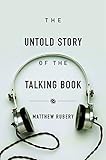The untold story of the talking book /Matthew Rubery.
Material type: TextPublication details: Cambridge, Massachusetts : Harvard University Press, (c)2016.Description: 1 online resource (369 pages) : illustrationsContent type:
TextPublication details: Cambridge, Massachusetts : Harvard University Press, (c)2016.Description: 1 online resource (369 pages) : illustrationsContent type: - text
- computer
- online resource
- 9780674974555
- 9780674974531
- Z286 .U586 2016
- COPYRIGHT NOT covered - Click this link to request copyright permission: https://lib.ciu.edu/copyright-request-form
| Item type | Current library | Collection | Call number | URL | Status | Date due | Barcode | |
|---|---|---|---|---|---|---|---|---|
 Online Book (LOGIN USING YOUR MY CIU LOGIN AND PASSWORD)
Online Book (LOGIN USING YOUR MY CIU LOGIN AND PASSWORD)
|
G. Allen Fleece Library ONLINE | Non-fiction | Z286.83 (Browse shelf(Opens below)) | Link to resource | Available | ocn965734378 |
"This work is the first history of recorded literature since Thomas Edison's invention of the phonograph in 1877. It traces the tradition from phonographic books made on wax cylinders to talking books made for blinded soldiers returning from the First World War and, much later, the commercial audiobooks heard today. Addressing the vexed relationship between orality and print, the author shows how talking books developed both as a way of reproducing printed books and as a way of overcoming their limitations. In a wide-ranging overview, he charts the talking book's evolution across numerous media (records, tapes, discs, digital files), its reception by a bemused public, and impassioned disputes over its legitimacy. Testimonials drawn from the archives of charities for war-blinded veterans and pioneering audio publishers including Caedmon, Books on Tape, and Audible vividly recreate how audiences over the past century have responded to literature read out loud. This book poses a series of conceptual questions too: What exactly is the relationship between spoken and printed texts? How does the experience of listening to books compare to that of reading them? What influence does a book's narrator have over its reception? What methods of close listening are appropriate to such narratives? What new formal possibilities are opened up by sound recording? Sound technology turns out to be every bit as important as screens to the book's ongoing transformation. In sum, this book breaks from convention by treating audiobooks as a distinctive art form that has profoundly influenced the way we read."--
Includes bibliographies and index.
What is the history of audiobooks? -- The phonographic library. Canned literature -- Blindness, disability, and talking book records. A talking book in every corner of dark-land ; How to read a talking book ; A free press for the blind ; From shell shock to shellac ; Unrecordable -- Audiobooks on and off the road. Caedmon's third dimension ; Tapeworms ; Audio revolution -- Afterword : speed listening.
COPYRIGHT NOT covered - Click this link to request copyright permission:
There are no comments on this title.
